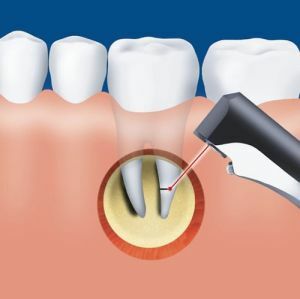 At this stage of modern dentistry, cystectomy and cystotomy are the most effective operations to remove the root tooth cyst.
At this stage of modern dentistry, cystectomy and cystotomy are the most effective operations to remove the root tooth cyst.
These are dental-preserving operations, after their carrying out there is no need to install a prosthesis or implant.
Until recently, with the cysts immediately removed the damaged tooth, but today it is considered an incorrect approach.
Contents
- Indications and contraindications in operation
- Difference in physician's actions
- Stages of complete cyst removal
- Rehabilitation period
- Possible complications
- Partial resection
- Recovery period
- Price
Indications and contraindications in operation
The cyst is a tissue cavity filled with liquid. These tumors can appear near the roots of dead teeth, under crowns or around them. Most often, the cysts are located next to the damaged teeth, into which the infection has fallen. They can also appear because of an anatomically incorrectly placed tooth.
Most often, neoplasms appear near the root. They are caused by an infectious process that affects the entire dental canal. There are cases when such formations appear around the teeth of wisdom.
Cystectomy may be prescribed with:
- affecting a cavity of several teeth;
- development of education in a place where there is no tooth, if the anatomical structure of the lower jaw allows for an operation without complications;
- occurrence of cysts due to disturbances in the development of odontogenic epithelium;
- the location of the cyst in the upper jaw, with no tooth and permissible bone thickness at the site of the intended intervention.
Cystotomy is prescribed if: the 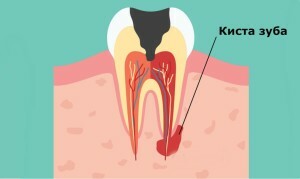
- cavity affects several healthy teeth;
- has a large formation in the upper part of the jaw and it destroys the bony bottom of the nose and palatine plate;
- on the lower jaw a new growth has arisen and the thickness of the jaw is less than the norm.
Both types of surgical interventions can not be performed with heart pathologies, viral diseases, badly broken crowns or mobile teeth.
Contraindications for both procedures are the same, only cystectomy can not be performed even with very large cysts and tooth mobility. The procedure is more traumatic, but the wound is restored within a few months. The cost of 9 to 12 thousand rubles.
Difference in the actions of a physician
Cystectomy and cystotomy have some distinctive features.
In the first case, the tumor is completely removed during the treatment. Prescribe such treatment, when the anomaly affects several teeth at once, or the cavity is large and at the same time the thickness of the upper and lower jaws allow to perform the operation.
In the second case, during the procedure, not all the tumor is removed, but its front wall, and the rest is connected with the oral cavity.
The indications are cystic formation, which affects three intact teeth, as well as large and large neoplasms on the upper and lower jaw.
It is forbidden for malignant neoplasms, severe pathologies of internal organs. Easier to tolerate, but the recovery process can last more than a year. The cost is about 7 thousand rubles.
Stages of complete cyst removal
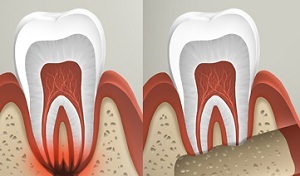 Radical cystectomy is usually performed together with resection of the apex of the root near which it is located. This surgical intervention is prescribed in the case when conservative therapy does not give the desired results. You can carry out the procedure on the upper and lower jaw.
Radical cystectomy is usually performed together with resection of the apex of the root near which it is located. This surgical intervention is prescribed in the case when conservative therapy does not give the desired results. You can carry out the procedure on the upper and lower jaw.
The main goal is to remove the cavity along with all its contents to prevent the spread of the infectious process. The tooth, near which the growth was located, remains intact and safe and can perform its functions for many years.
The patient is first prepared for surgery. A few days before the procedure, the root canal is sealed.
The operation is carried out in several stages:
- The patient is given a conductive or infiltration anesthesia.
- When the anesthesia begins to act, soft tissue before the bone is cut and peeled.
- The drill is removed a thin cortical plate.
- A surgical spoon exfoliate the cyst.
- Carry out a resection of the apex of the root, which eliminates the focus of inflammation, and the tooth can be saved. This procedure allows you to eliminate the remnants of the cyst and prevent its recurrence.
- If during inspection it was possible to find out that there is no cement in the root canal, then fillings are performed. This prevents the development of inflammation, due to infection in the wound from the root canal.
- The formed cavity is filled with bone-forming substance. It is necessary that soft tissues do not germinate. Gradually the tissue in the operated region is restored.
- The wound is sutured.
Rehabilitation period
The procedure lasts no longer than an hour. The rehabilitation period lasts about two months. In the first days after the removal of the formation of pain and swelling of the tissues. The patient during this period is recommended to use preparations of anti-inflammatory and antibacterial action. Sutures are removed after two weeks.
Do not eat solid food for several months. Six months after surgery, it is necessary to make an X-ray. To make sure that the tissue repair was successful.
Possible complications of
If the procedure was not performed correctly and the cyst was not removed completely, a relapse of the disease is ensured. Therefore, 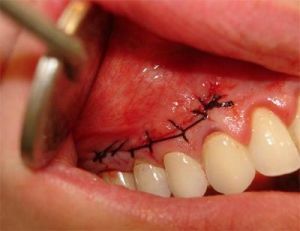 should only be addressed to experienced specialists. In addition, such complications can arise:
should only be addressed to experienced specialists. In addition, such complications can arise:
- accidental removal of malignant neoplasm, this procedure requires special precautions;
- jaw fracture, if its thickness was less than recommended;
- infection can occur in the wound.
But, in principle, this procedure is considered a quick and efficient operation. If the intervention is performed by specialists, the recovery process passes quickly and no complications arise. But with larger cavities, the operation will last longer and it will be necessary to perform bone reconstruction.
The cyst was removed pretty quickly. After the operation, I felt no numbness and other discomfort. For me it is very important, since the profession obliges to negotiate and can not remain silent for a long time. The result is very satisfied.
Andrei, 40 years
Partial resection
In the course of cystotomy, the front wall of the cyst is removed and the area of its communication with the oral cavity. This is less complicated and traumatic procedure than cystectomy.
It is easier to tolerate by patients, but after the procedure there is a defect, which must be properly taken care of for a long time.
Only the injured tooth is prepared for surgical intervention. The procedure itself consists of the following stages:
- operation is performed under local anesthesia, so the patient is first given an anesthetic drug;
- cut the mucosa and the submucosal layer of the gum;
- remove the wall of the cyst, and its cavity is cleaned of all contents;
- cystic wall sutured to the edge of the wound of the oral mucosa;
- treats the damaged tooth with antiseptic agents;
- after completion of the procedure in iodine solution soak a cotton swab and apply it to the wound;
- a week later replace the tampon, because due to mucosal it is rejected.
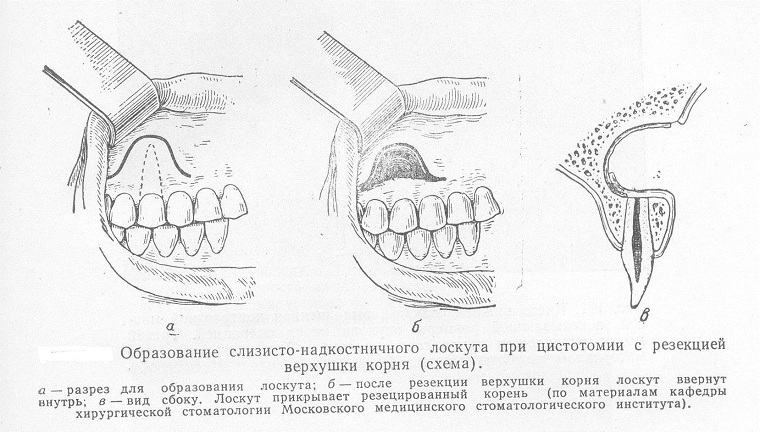
Recovery period
After the operation it is necessary:
- to take anti-inflammatory and antibacterial drugs;
- is prescribed funds to relieve pain;
- carefully monitor hygiene of the teeth.
In large cases, the recovery period can last up to two years. Dysfunction is observed throughout the week. The plus of this procedure is that most patients suffer it much better than cystectomy.
An important part of the treatment is the use of antibacterial drugs that destroy pathogenic microorganisms and prevent the development of purulent processes. Gradually, after the formation resolves, the wounds heal.
How successful recovery will depend not only on the correctness of the procedure, but also on the patient's compliance with the doctor's recommendations.
After the operation, it is necessary to limit physical activity, perform hygienic procedures carefully, use only soft and warm food. From alcoholic beverages and cigarettes will have to refrain.
Possible complications, as in the case of cystectomy, are possible infection of the wound, relapse of the disease, damage to the nerve, tooth root.
On the examination at the dentist found a cyst. The expert advised to remove her by the method of cystotomy, since there were indications for her conduct. The procedure under local anesthesia was carried out very quickly. There were no complications.
Nicholas, 25 years
Price
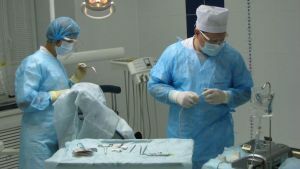 Positive aspects of cystotomy are the effectiveness of the operation, the minimum chances of occurrence of a relapse, the duration of a positive result. Perform the procedure better in modern clinics, where the cost of it will vary within seven thousand rubles.
Positive aspects of cystotomy are the effectiveness of the operation, the minimum chances of occurrence of a relapse, the duration of a positive result. Perform the procedure better in modern clinics, where the cost of it will vary within seven thousand rubles.
With regard to cystectomy, if the procedure is performed on the frontal tooth and the filling will be performed additionally, the patient will cost nine thousand rubles. The operation on the lateral tooth will cost several thousand more.
Both methods of treatment are effective and modern, allow you to get rid of the disease with a low probability of relapse. Complications after both procedures may occur, but it all depends on the professionalism of the specialists and the patient's consciousness. If the operation was successful, but the patient does not follow the doctors' recommendations, the healing process can be delayed for a long time.
